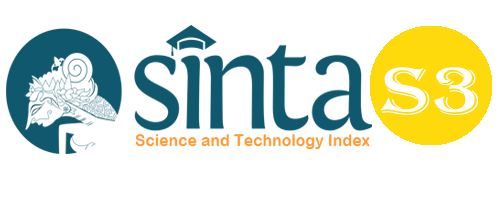The Capital Asset Pricing Model Forecast Using Artificial Intelligence
Abstract
The application of Artificial Intelligence (AI) with the Recurrent Neural Network (RNN) Long Short-Term Memory (LSTM) algorithm which has excellent accuracy in predicting stock prices, but still needs to be developed optimally in the accounting and finance fields. In many cases it was found that the value of the results of the traditional Capital Asset Pricing Model (CAPM) calculations was consistently below the estimated return. Therefore, it is necessary to calculate the CAPM that can optimize the estimated returns more accurately, by combining it using AI technology with the LSTM method RNN algorithm. The purpose of this study is to prove the accuracy of the CAPM calculation results generated by AI compared to the traditional CAPM calculation method in providing an estimate of the return on the best blue-chip group in the LQ45 index during the 2015-2019 observation period. The sample of this study uses data on closing prices adjusted for companies with the lowest Debt to Equity Ratio (DER). The results of the adjusted closing price prediction using AI with the LSTM method have high accuracy. From the analysis of the different paired sample t-test, it was found that there was a significant difference in the mean Absolute Percentage Error (MAPE), where the AI-optimized CAPM model had a lower MAPE value than the traditional CAPM model. This study concludes that the AI-optimized CAPM calculation method has proven to be able to provide more accurate return estimates than traditional CAPM calculation methods.
Keywords
Full Text:
PDFReferences
Afzal, F., & Haiying, P. (2020). Evaluating the Effectiveness of CAPM and APT for Risk Measuring and Assets Pricing. Financial Risk and Management Reviews, 6(1). https://doi.org/10.18488/journal.89.2020.61.14.21
Agarwal, V., Green, T. C., & Ren, H. (2018). Alpha or beta in the eye of the beholder: What drives hedge fund flows? Journal of Financial Economics, 127(3). https://doi.org/10.1016/j.jfineco.2018.01.006
Bhowmick, A., Rahman, A., & Rahman, R. M. (2019). Performance analysis of different recurrent neural network architectures and classical statistical model for financial forecasting: A case study on Dhaka stock exchange. Advances in Intelligent Systems and Computing, 985. https://doi.org/10.1007/978-3-030-19810-7_27
CFA Institute. (2019). AI Pioneers in Investment Management. https://www.cfainstitute.org/-/media/documents/survey/AI-Pioneers-in-Investment-Management.ashx
Chang, P. C., Wang, Y. W., & Liu, C. H. (2007). The development of a weighted evolving fuzzy neural network for PCB sales forecasting. Expert Systems with Applications, 32(1). https://doi.org/10.1016/j.eswa.2005.11.021
Eliasy, A., & Przychodzen, J. (2020). The role of AI in capital structure to enhance corporate funding strategies. Array, 6. https://doi.org/10.1016/j.array.2020.100017
Hakim, M. Z., & Naelufar, Y. (2020). Analysis of Profit Growth, Profitability, Capital Structure, Liquidity and Company Size of Profit Quality. Jurnal Akademi Akuntansi, 3(1). https://doi.org/10.22219/jaa.v3i1.10348
Helia, S., Putra, E.E., and Hidayati, H. (2020). Firm Size and Price Book Value Impact on Stock Return: Evidence from the Indonesian Stock Exchange. Budapest International Research and Critics Institute-Journal (BIRCI-Journal) Vol 3 (3): 2567a-2567i.
Hochreiter, S., & Schmidhuber, J. (1996). Bridging long time lags by weight guessing and “Long Short-Term Memory.” In Spatiotemporal Models in Biological and Artificial Systems.
Hou, K., Mo, H., Xue, C., & Zhang, L. (2019). Which factors? Review of Finance, 23(1), 1–35.
Indra, Y. A. (2018). Perbandingan Keakuratan Metode Capital Asset Pricing Model dan Arbitrage Pricing Theory dalam Memprediksi Return Saham (Studi pada Perusahaan Sektor Barang Konsumsi dan Sektor Pertambangan yang Terdaftar di Indeks Saham Syariah Indonesia (ISSI) Peri. Journal of Economic, Bussines and Accounting (COSTING), 1(2). https://doi.org/10.31539/costing.v1i2.223
Jogiyanto, H. (2017). Teori portofolio dan analisis investasi (edisi Kesebelas). In Yogyakarta: BPFE.
Jones, C., & O’Reilly, A. (2012). Investments: Analysis and Management, 12th Edition. John Wiley & Sons.
Kaplan, A., & Haenlein, M. (2019). Siri, Siri, in my hand: Who’s the fairest in the land? On the interpretations, illustrations, and implications of artificial intelligence. In Business Horizons (Vol. 62, Issue 1). https://doi.org/10.1016/j.bushor.2018.08.004
Lubis, T. A., Octavia, A., & Fitri, W. (2019). Rating of LQ-45 stock index performance credibility in Indonesia Stock Exchange. Jurnal Perspektif Pembiayaan Dan Pembangunan Daerah, 6(5). https://doi.org/10.22437/ppd.v6i5.6707
Manurung, A. H., Budiharto, W., & Prabowo, H. (2018). Algorithm and modeling of stock prices forecasting based on long short-term memory (LSTM). ICIC Express Letters, 12(12). https://doi.org/10.24507/icicel.12.12.1277
Qian, F., & Chen, X. (2019). Stock prediction based on LSTM under different stability. 2019 IEEE 4th International Conference on Cloud Computing and Big Data Analytics, ICCCBDA 2019. https://doi.org/10.1109/ICCCBDA.2019.8725709
Siami-Namini, S., Tavakoli, N., & Siami Namin, A. (2019). A Comparison of ARIMA and LSTM in Forecasting Time Series. Proceedings - 17th IEEE International Conference on Machine Learning and Applications, ICMLA 2018. https://doi.org/10.1109/ICMLA.2018.00227
Solihin, I., et.al. (2021). Convergence of Three Binomial Models into Black Scholes Model in Establishing Option Prices in Hongkong, India, and Indonesia. Budapest International Research and Critics Institute-Journal (BIRCI-Journal) Vol 4 (3): 6198-6210.
Supriyanto, & Hendri, J. (2021). Analisis Pengaruh Tata Kelola Perusahaan Dan Struktur Modal Terhadap Kinerja Perseroan. Jurnal Akademi Akuntansi, 4(2), 246–296.
Suroso, S., Rusiadi, Purba, R. B., Siahaan, A. P. U., Sari, A. K., Novalina, A., & Lubis, A. I. F. (2018). Autoregression vector prediction on banking stock return using capm model approach and multi-factor apt. International Journal of Civil Engineering and Technology, 9(9). https://doi.org/10.31227/osf.io/yqvxa
Ta, V. D., Liu, C. M., & Tadesse, D. A. (2020). Portfolio optimization-based stock prediction using long-short term memory network in quantitative trading. Applied Sciences (Switzerland), 10(2). https://doi.org/10.3390/app10020437
Yunita, I., Gustyana, T. K., & Kurniawan, D. (2020). Accuracy Level of Capm and APT Models in Determining the Expected Return of Stock Listed on LQ45 Index. Journal of Management Applications, 18(4), 797–807.
Zhang, L. (2017). The Investment CAPM. European Financial Management, 23(4). https://doi.org/10.1111/eufm.12129
DOI: https://doi.org/10.33258/birci.v5i1.3677
Article Metrics
Abstract view : 171 timesPDF - 108 times
Refbacks
- There are currently no refbacks.

This work is licensed under a Creative Commons Attribution-ShareAlike 4.0 International License.

This work is licensed under a Creative Commons Attribution-ShareAlike 4.0 International License.

_.gif)

















_.gif)



